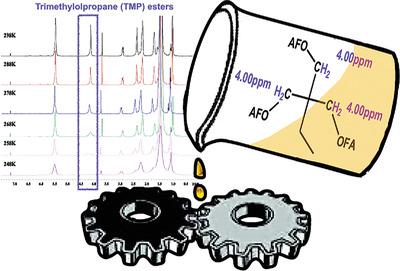当前位置:
X-MOL 学术
›
Eur. J. Lipid Sci. Technol.
›
论文详情
Our official English website, www.x-mol.net, welcomes your feedback! (Note: you will need to create a separate account there.)
Characterization of Trimethylolpropane‐Based Biolubricant
European Journal of Lipid Science and Technology ( IF 2.7 ) Pub Date : 2020-06-03 , DOI: 10.1002/ejlt.202000025 Jieyu Nie 1 , Youn Young Shim 1, 2, 3, 4 , Jianheng Shen 1 , Timothy J. Tse 1 , Martin J. T. Reaney 1, 2, 3
European Journal of Lipid Science and Technology ( IF 2.7 ) Pub Date : 2020-06-03 , DOI: 10.1002/ejlt.202000025 Jieyu Nie 1 , Youn Young Shim 1, 2, 3, 4 , Jianheng Shen 1 , Timothy J. Tse 1 , Martin J. T. Reaney 1, 2, 3
Affiliation

|
The oxidative stability index (OSI) of fatty acid methyl esters (FAME) and trimethylolpropane (TMP) esters or TMPE produced from five vegetable oils (Brassica rapa L., Linum usitatissimum L., Zea mays L., Brassica napus L., Camelina sativa L.) are compared. The highest stability is observed in vegetable oils while the processed products are less stable. The major causes in loss of OSI are attributed to excess FAME in the crude product and the loss of natural antioxidants due to refinement with silica and celite. The low‐temperature flow properties of TMPE produced from four different vegetable oils (B. juncea L., L. usitatissimum L., B. rapa L., and C. sativa L.) are investigated by proton nuclear magnetic resonance (1H‐NMR). The T2 relaxations of different TMPE are measured to observe how the mobility of oil changed as temperature decreased. Increased oil mobility (represented by T2) is correlated with rising temperature. The Gaussian widths of the singlet in 1H‐NMR spectra of each oil demonstrated increased molecular mobility as temperature increased. Extrapolation of the relation of T2 signals of these four oils indicates that T2 approached zero between 232 K and 239 K, suggesting the molecular motion leading to a T2 relaxation has largely ceased.
中文翻译:

基于三羟甲基丙烷的生物润滑剂的表征
氧化稳定性指数的脂肪酸甲基酯(OSI)(FAME)和三羟甲基丙烷(TMP)的酯或TMPE从五个植物油(产生芜菁大号。,亚麻大号。,玉蜀黍大号。,欧洲油菜大号。,亚麻荠苜蓿)。在植物油中观察到最高的稳定性,而加工产品的稳定性较差。OSI损失的主要原因归因于原油产品中过量的FAME,以及由于用二氧化硅和硅藻土精制而导致的天然抗氧化剂的损失。TMPE的低温流动性能从四个不同的植物油(产生芥菜L.,L. usitatissimum L.,芜菁L.和C. sativa L.)是通过质子核磁共振(1 H-NMR)研究的。测量不同TMPE的T2弛豫,以观察油的迁移率如何随温度降低而变化。油的流动性增加(由T2表示)与温度升高相关。每种油的1 H-NMR光谱中的单峰高斯宽度显示出随着温度升高分子迁移率增加。外推这四种油的T2信号的关系表明,T2在232 K和239 K之间接近零,这表明导致T2弛豫的分子运动已基本停止。
更新日期:2020-06-03
中文翻译:

基于三羟甲基丙烷的生物润滑剂的表征
氧化稳定性指数的脂肪酸甲基酯(OSI)(FAME)和三羟甲基丙烷(TMP)的酯或TMPE从五个植物油(产生芜菁大号。,亚麻大号。,玉蜀黍大号。,欧洲油菜大号。,亚麻荠苜蓿)。在植物油中观察到最高的稳定性,而加工产品的稳定性较差。OSI损失的主要原因归因于原油产品中过量的FAME,以及由于用二氧化硅和硅藻土精制而导致的天然抗氧化剂的损失。TMPE的低温流动性能从四个不同的植物油(产生芥菜L.,L. usitatissimum L.,芜菁L.和C. sativa L.)是通过质子核磁共振(1 H-NMR)研究的。测量不同TMPE的T2弛豫,以观察油的迁移率如何随温度降低而变化。油的流动性增加(由T2表示)与温度升高相关。每种油的1 H-NMR光谱中的单峰高斯宽度显示出随着温度升高分子迁移率增加。外推这四种油的T2信号的关系表明,T2在232 K和239 K之间接近零,这表明导致T2弛豫的分子运动已基本停止。



























 京公网安备 11010802027423号
京公网安备 11010802027423号